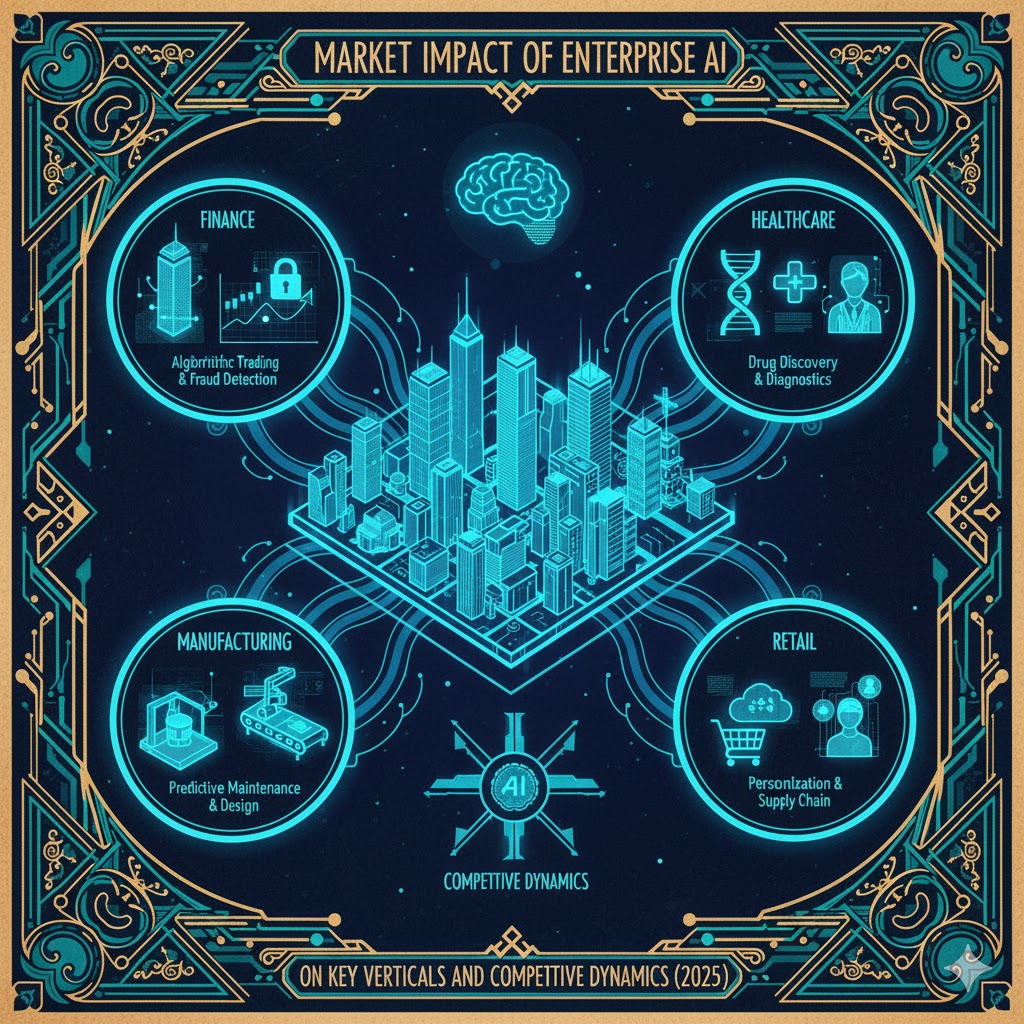Introduction
Generative and agentic AI have progressed from experimental pilots to production‑scale deployments. High‑profile pilots such as NHS England’s Microsoft 365 Copilot programme and Citigroup’s AI‑enabled developer tools show that time savings can be transformative rather than incremental. The market impact of these and other initiatives will be felt across industry verticals, altering cost structures, productivity, talent requirements and competitive positioning. To provide context, this report synthesises data from recent governmental releases, industry reports and market analyses (all current as of 26 Oct 2025 in Europe/Berlin). It examines how AI adoption in different sectors unlocks efficiency and reshapes competitive dynamics, while noting limits such as the early nature of many pilots and the need for better impact measurement.
Key enterprise‑scale case studies
| Initiative | Scale and outcomes | Evidence |
|---|---|---|
| NHS England & Microsoft 365 Copilot pilot (UK) | Deployed across 90 NHS organisations, involving over 30,000 staff. The pilot showed that Copilot’s AI assistance saved ~43 minutes per staff member per day (≈five working weeks per person). Extrapolated across the NHS, this equates to up to 400 000 staff hours per month, especially through automatic note‑taking of Teams meetings (≈83 333 hours/month) and summarising email threads (≈271 000 hours/month)gov.uk. This productivity improvement could save the NHS millions of pounds annuallygov.uk. | Government press release (Oct 2025)gov.uk;the 10 Year Health Plan notes a 2.7 % productivity increase in acute trusts in 2024–25gov.uk. The Peterson Health Technology Institute (PHTI) reviewed the pilot in its early‑adoption report and highlighted that time‑saving evidence is promising but longer‑term data and standardized metrics are neededphti.org. |
| Citigroup AI‑assisted developer tools (USA) | Citigroup introduced internal AI tools (e.g., Citi Assist, Citi Stylus and Citi Squad) to automate code reviews, debugging and documentation across ~180 000 employees. CEO Jane Fraser told analysts that the deployment has freed ~100 000 developer hours per weekreuters.com. A Reuters report notes that the tools are available in 83 countries, and Citi’s Q2 2025 results report ~740 000 automated code reviews saving ≈100 k hours/week. | Reuters report (Oct 2025)reuters.com; AIM Media House analysis (Oct 2025) provides further context, noting that tasks such as coding and documentation are being handled by generative modelsaimmediahouse.com and that the productivity boost allows Citi to develop products faster and respond to regulatory changesaimmediahouse.com. |
| PHTI ambient scribe & administrative AI report (USA) | The PHTI’s March 2025 report stresses that ambient scribe tools (which turn clinician–patient conversations into structured notes) show early promise for reducing clinician burnout. However, the evidence base for direct efficiency gains remains limited; published studies show mixed results, and standardized metrics and longitudinal data are needed to evaluate clinician impact, patient outcomes and financial valuephti.org. | PHTI report (March 2025)phti.org. |
These cases illustrate that AI can free tens of thousands of staff hours per month when embedded into familiar workflows (email, meetings or code reviews). They also highlight the need for robust evaluation frameworks as adoption scales.
Vertical‑specific benefits and market impact
Healthcare
Administrative relief and clinician productivity: Healthcare organisations are early adopters of AI because they generate large volumes of unstructured data and face persistent labour shortages. The NHS pilot demonstrates that embedding AI into existing productivity tools can reduce the administrative burden on clinicians and support staff—potentially redirecting more time to patient care. The government estimates that Microsoft 365 Copilot could save up to 400 000 hours per month by summarising meetings and email threadsgov.uk. Early evidence from ambient scribe deployments suggests that AI can reduce cognitive load and clinician burnout, although time‑savings evidence remains mixed and requires standardised metrics for evaluationphti.org. PHTI notes that ambient scribe adoption is particularly strong in primary care and is expanding into nursing, revenue cycle and referralsphti.org.
Clinical decision support and precision medicine: AI tools are also being used for medical imaging (e.g., PathAI for pathology and Tempus for precision oncology)coherentsolutions.com, drug discovery and clinical trial optimisation. Healthcare verticals often rely on sector‑specific (so‑called vertical AI) models trained on clinical data to maintain accuracy and regulatory compliance. The UK government’s adoption of Copilot indicates that mainstream productivity suites can integrate with vertical AI solutions.
Market impact: The combined effect of administrative AI and clinical AI could help healthcare systems manage rising demand with constrained budgets. Top AI spenders include healthcare providers and pharma/biotech companiescoherentsolutions.com. Increased efficiency may allow providers to treat more patients or reduce waiting lists, offering competitive advantage to organisations that adopt AI early. However, PHTI cautions that financial benefits such as improved coding (E&M or HCC coding) could drive higher healthcare spending if not managed carefullyphti.org. Competition may arise between traditional healthcare IT vendors and new entrants offering AI‑enabled administrative tools.
Financial services
Software development and back‑office automation: The Citi case shows how generative AI accelerates software development, freeing ~100 000 developer hours per week across tens of thousands of engineersreuters.com. By automating code reviews and documentation, AI shortens product development cycles and enhances regulatory compliance. Such scale gives incumbents like Citi a productivity edge over smaller banks and fintechs, potentially widening the gap.
Customer service and compliance: AI is also used in financial services for fraud detection, robo‑advisory, risk modelling and customer support. The Coherent Solutions report notes that mass AI adoption in financial services could generate up to $1.2 trillion extra gross value added (GVA) by 2035coherentsolutions.com. Banks like JPMorgan and Bank of America are developing large‑language‑model suites to automate investment banking presentations, memo drafting and compliance monitoringaimmediahouse.com. Fintechs employing AI for identity verification and payments processing are scaling quickly, raising competitive pressure on traditional banks.
Market impact: AI reduces marginal costs and accelerates product rollout, which is critical in an industry characterised by thin margins and stringent regulations. Large incumbents with budgets to invest in AI may gain first‑mover advantage. However, new fintech entrants leveraging open‑source models could challenge incumbents; the low cost of AI tools lowers barriers to entry. Regulatory agencies are also exploring AI for transaction monitoring and anomaly detection, which may standardise compliance but also increase oversight costs.
Law and professional services
Productivity gains but billing model challenges: Large law firms see AI as transformative. Interviews with partners at AmLaw 100 firms reveal that AI tools for drafting litigation responses can reduce associate time from 16 hours to 3–4 minutes, producing >100× productivity gainsclp.law.harvard.edu. However, because law firms operate under a billable‑hour model (≈80% of fee arrangements)clp.law.harvard.edu, increased efficiency threatens revenue unless firms adjust pricing. Firms expect to maintain headcount but redeploy lawyers to higher‑value analysis and client strategyclp.law.harvard.edu. Some anticipate “80/20 inversion,” with more time spent on strategy than information gatheringclp.law.harvard.edu.
Adoption statistics and time savings: The 2025 Thomson Reuters Future of Professionals report surveyed 2 275 professionals across law, tax and other fields. 77% of legal professionals using AI rely on it for document review, 74% for legal research and 74% for summarising documentslegal.thomsonreuters.com. The report notes that AI tools could save lawyers around 240 hours per yearlegal.thomsonreuters.com—equivalent to 30 workdays—and that 80% of respondents believe AI will have a high or transformational impact on their work within five yearslegal.thomsonreuters.com. Pilot projects show dramatic time reductions in tasks like contract drafting and memo preparationlegal.thomsonreuters.com.
Market impact: Early adopters may offer faster, cheaper legal services, threatening slower competitors and opening opportunities for alternative legal service providers (ALSPs) to capture commoditised work. However, ethical and confidentiality concerns, plus the need for accuracy in legal outputs, slow widespread adoptionlegal.thomsonreuters.com. As clients increasingly demand AI‑enabled efficiency, law firms will need to adapt pricing models, invest in training and differentiate themselves through proprietary knowledge bases and AI governance frameworks.
Marketing and customer experience
Ubiquitous adoption: A 2025 survey of 1 229 marketers indicates that 89.5 % have integrated AI into their processes and 93.5 % of those use generative AI toolsoutcomesrocket.com. Generative models are used for creating blog posts, ad copy and design assets; 82.4 % of marketers deploy AI for content creationoutcomesrocket.com. However, trust remains an issue: 93.4 % of marketers encounter errors or bias in AI‑generated content, so 71.1 % never publish AI‑generated output without human reviewoutcomesrocket.com. Training is lacking—80.8 % report no formal training from employersoutcomesrocket.com.
Productivity gains: AI delivers measurable time savings for marketers; 86 % report saving an average of 4.74 hours per weekoutcomesrocket.com. ChatGPT is the dominant tool, used by 94.8 % of generative AI usersoutcomesrocket.com.
Market impact: Low barriers to adoption enable small businesses and individual creators to compete with larger marketing agencies. However, reliance on widely accessible tools reduces differentiation. Marketing firms can create competitive advantage through proprietary datasets, brand voice fine‑tuning and agentic AI that automates multi‑step campaigns. The industry will likely see consolidation of generic content creation tasks alongside new niches for human‑curated, high‑quality storytelling.
Manufacturing and supply chain
Adoption rates: The 2025 State of AI in Manufacturing survey (referenced by Coherent Solutions) reports that over 77 % of manufacturers had implemented AI by 2025, up from 70 % in 2023coherentsolutions.com. AI is primarily used for production optimisation (31 %), customer service (28 %) and inventory management (28 %)coherentsolutions.com. Many manufacturers prefer collaborative “copilot” bots (53 %) over fully autonomous systemscoherentsolutions.com, reflecting the desire to augment rather than replace human workers. Key investment areas include supply‑chain management (49 %) and big data analytics (43 %)coherentsolutions.com, while 56 % are unsure if their ERP systems are ready for full AI integrationcoherentsolutions.com.
Use cases: Cobots, generative design, quality assurance, predictive maintenance and demand forecasting are prominent. A 2023 Accenture study predicts AI could add $3.8 trillion in extra GVA to manufacturing by 2035coherentsolutions.com. Manufacturers adopt AI to enhance design and shorten product lifecycles, enabling mass customisation.
Market impact: First movers gain cost advantages through reduced downtime and improved quality control. Smaller manufacturers can access AI via cloud platforms, while large firms build proprietary digital twins. Talent shortages (data engineers, robotics specialists) and interoperability with legacy systems remain obstacles. Competitive pressure will likely drive consolidation and partnerships among manufacturers, robotics companies and AI vendors.
Retail and e‑commerce
Customer engagement and conversion: Retailers are deploying AI chatbots and recommendation engines. Deloitte’s 2025 US retail outlook cited by Coherent Solutions notes that retailers achieved 15 % higher conversion rates during the Black Friday weekend after using chatbotscoherentsolutions.com. IBM research suggests retail and consumer products companies will make some of the most extensive use of AI, leveraging it for personalisation, inventory management and pricing optimisationcoherentsolutions.com.
Agentic shopping agents and design tools: Autonomous shopping agents can browse items, place orders and personalise recommendationsitpathsolutions.com. Tools like Wayfair’s Decorify generate home design suggestions, improving customer satisfaction and conversionsitpathsolutions.com. Generative AI also enables digital try‑ons and product design.
Market impact: AI allows retailers to deliver personalised experiences at scale, eroding the advantage of physical stores. However, data privacy and mis‑personalisation risks persist. Competition intensifies as e‑commerce platforms integrate generative AI, while brick‑and‑mortar retailers must invest in omnichannel experiences and data infrastructure to stay relevant.
Media and entertainment
Cost reduction and content proliferation: Morgan Stanley’s 2025 analysis estimates that generative AI could reduce overall media industry costs by about 10 % and TV/film production costs by up to 30 %morganstanley.com. Generative AI accelerates scriptwriting, editing, visual effects and localisation, enabling faster production cycles and allowing savings to be reinvested in talent and sports rightsmorganstanley.com. Smaller producers can now create high‑quality content, challenging the dominance of major studiosmorganstanley.com.
Curation and live experiences: Gen AI enhances music curation and personalisation, increasing engagement and potentially boosting live event demandmorganstanley.com. Artists can produce professional‑quality recordings from homemorganstanley.com, lowering barriers to entry.
Market impact: While AI democratises content creation, it may lead to industry consolidation if major tech companies combine AI capabilities with distribution networks, intellectual property and marketing powermorganstanley.com. Incumbent media conglomerates must navigate labour disputes over IP rights and residuals for AI‑generated content, while regulators consider new rules around copyright and synthetic media.
Telecom and IT services
Network optimisation and AI‑RAN: In telecoms, AI is used for network planning, predictive maintenance, customer experience and network slicingcoherentsolutions.com. The AI‑RAN Alliance (launched in Feb 2024) brings together telecom and tech leaders to merge AI with radio access networkscoherentsolutions.com. Coherent Solutions cites projections that AI could contribute $4.7 trillion in gross value to IT and telecom by 2035coherentsolutions.com. Leading carriers are developing AI‑driven self‑optimising networks and customer service chatbots.
Market impact: AI reduces operational costs and improves network reliability, enabling carriers to offer differentiated services (e.g., low‑latency slices for gaming or industrial IoT). However, adoption requires heavy investment, and carriers must partner with AI vendors. The AI‑RAN Alliance may accelerate standards, benefitting early participants.
Competitive dynamics and the rise of vertical AI
Convergence of general‑purpose and vertical AI
Across sectors, firms are shifting from generic models to vertical AI—systems trained on industry‑specific data that embed domain knowledge, regulations and workflows. Vertical AI promises higher accuracy and reliability, making it suitable for safety‑critical sectors such as healthcare, legal and financial services. The NHS Copilot pilot demonstrates how general‑purpose productivity AI can integrate with regulated systems by summarising emails and meetings, but deeper clinical applications require specialised models. Meanwhile, Citigroup’s tools illustrate how internal LLMs can be trained on proprietary code bases to automate software engineering without exposing sensitive data.
Impact on competition
- Lower barriers to entry for challengers: AI reduces the fixed costs of content creation, software development and marketing. In media, independent creators can generate professional‑quality films and music, threatening incumbentsmorganstanley.com. In marketing, small businesses can use ChatGPT and off‑the‑shelf tools to produce high‑quality campaignsoutcomesrocket.com. This democratisation fosters competition and may erode the advantage of firms whose value was previously tied to economies of scale.
- Scale advantages for incumbents: Conversely, companies with large proprietary datasets (e.g., banks, healthcare systems) have advantages in training vertical AI models. Citigroup’s ability to free 100 k hours/week shows that large incumbents can leverage AI to enhance productivity and meet regulatory requirementsreuters.com. In healthcare, providers with integrated EHR systems and data partnerships will build superior clinical decision models. These advantages may lead to winner‑take‑most dynamics.
- New entrants and ecosystem players: AI vendors, cloud providers and startups offering domain‑specific models are emerging as critical ecosystem players. For example, ambient scribe companies compete to expand into nursing and revenue cycle managementphti.org. Fintech startups integrate generative models with banking APIs, while legal tech providers offer AI‑powered research and drafting tools. Partnerships between incumbents and AI specialists (e.g., AI‑RAN Alliance, Microsoft–NHS collaboration) will shape the competitive landscape.
- Potential for consolidation: In media, Morgan Stanley predicts that generative AI may spur consolidation if technology companies combine AI capabilities with distribution and IP portfoliosmorganstanley.com. Similar consolidation could occur in healthcare IT and fintech, where scale and regulatory compliance act as barriers to entry.
- Regulatory and ethical pressures: Increased AI use raises concerns over data privacy, bias, transparency and labour displacement. The PHTI emphasises the need for standardized metrics and long‑term studies to assess AI’s real impact on productivity and costsphti.org. In law, firms must ensure that AI outputs meet professional standards and maintain client confidentialitylegal.thomsonreuters.com. Regulatory frameworks (e.g., EU AI Act, U.S. financial regulators) could create compliance burdens that favour larger players.
Conclusion and outlook
AI adoption across verticals is accelerating, and early evidence from large-scale pilots suggests that the efficiency gains can be dramatic. In healthcare, administrative tools like Microsoft 365 Copilot could free hundreds of thousands of hours each monthgov.uk, while in finance, AI‑assisted coding frees tens of thousands of hours per weekreuters.com. Legal, marketing, manufacturing, retail, media and telecom sectors are also realising significant productivity gains.
However, the market impact is uneven. Early adopters and data‑rich incumbents are positioned to capture outsized benefits, while smaller firms without AI capabilities risk falling behind. At the same time, readily available generative AI tools lower barriers to entry in creative and service industries, intensifying competition. The emergence of vertical AI will likely reinforce both dynamics—enhancing the moat for incumbents with proprietary data and enabling nimble entrants to solve niche problems.
Key considerations for organisations planning AI strategies include:
- Integration and adoption: Embedding AI into existing workflows (as the NHS did) drives adoption and ensures time savings are realised at scale. Organisations must invest in change management and training to maximise benefits; marketers’ lack of formal training highlights this needoutcomesrocket.com.
- Data and partnerships: Building or accessing high‑quality domain data is essential for vertical AI. Partnerships with technology vendors, cloud providers and other organisations (e.g., AI‑RAN Alliance) can accelerate development and standards.
- Governance and measurement: Standardised metrics are necessary to evaluate AI’s true impact. PHTI calls for longitudinal studies of clinical, financial and patient outcomesphti.org. Law firms and financial institutions must implement rigorous governance to ensure compliance and ethical use.
- Business model evolution: AI‑driven efficiency may require new pricing models. Law firms may move away from pure billable hoursclp.law.harvard.edu, and healthcare providers might need to ensure that coding improvements do not drive unnecessary costsphti.org. Firms should consider how to monetise freed capacity—whether through new services, faster product release or improved client experience.
- Talent and reskilling: AI adoption creates demand for new roles (prompt engineers, data scientists, AI ethics officers) and requires reskilling of existing staff. Workforce development must keep pace to avoid bottlenecks and mitigate employee concerns about job security.
In summary, enterprise AI stands to deliver substantial efficiency gains across sectors, but its ultimate market impact will depend on how organisations align technology with strategy, governance and culture. The next phase will see vertical AI models become mainstream, with competition shaped by data access, adoption speed and regulatory frameworks.









